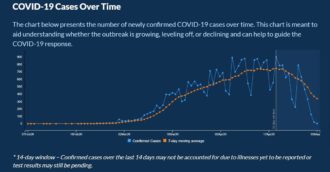By Aaron D. Levine
The national media have latched on to a recent Georgia Department of Public Health (GaDPH) chart that plotted dates in a confusing and potentially misleading order to mock the state and suggest it is cooking the books. Whether political considerations are interfering with public health reporting is an open question. What is clear, however, is that this poorly designed chart is illustrative of a larger problem.

The combination of obvious mistakes and questionable reporting decisions has called the state’s credibility into question and jeopardized trust in its COVID-19 data and the policies that rely on these data. As a result, Georgia desperately needs a COVID-19 reporting reboot.
Mistakes range from an unreadable chart that plotted COVID-19 cases on a scale that went back to 1970 to a chart that listed “FEMALE” and “Female” COVID-19 patients separately. At times, the errors have been more serious, with the number of total cases or total deaths increasing and then later decreasing.
Beyond these clear mistakes, the judgment demonstrated in designing the state’s reporting is worrisome as well. Scientists have developed two types of COVID-19 tests: viral tests to see if someone is currently infected and antibody tests to identify people infected in the past. Recent reports indicate that the state is combining these two distinct tests when reporting the total number of COVID-19 tests conducted. This decision yields a number that is essentially impossible to interpret and raises questions about the meaningfulness of the state’s recent increases in testing and decreases in its rate of positive tests for the virus — both of which are key metrics for public health professionals assessing the state’s recent reopening.

In addition, for several weeks the state has assigned COVID-19 cases to the date when symptoms started or when testing was conducted, if available. While this approach makes sense epidemiologically, it creates a lag in reporting that has led to substantial confusion. In particular, it means that the number of cases reported for recent dates will always understate the final number of cases assigned to those dates. Indeed, Georgia will not be able to report a final number of COVID-19 cases for yesterday until at least two weeks from now. This means that for the most recent two weeks – the very time period that is of most interest to viewers – the cases are always undercounted. This risks serious misinterpretation of the state’s data.
None of these examples inspires confidence in public health data that should be informing critical policy decisions. Georgians deserve better, and I encourage the state to rethink its COVID-19 reporting.
In addition to a commitment to quality assurance and transparency, the state needs to target the right audience. Unlike the vast majority of GaDPH reports, which are written for small specialist audiences of epidemiologists and public health professionals, COVID-19 is of widespread public interest. Indeed, a broad cross-section of Georgians – business leaders, school board members, local officials and many others – are using these data as they make decisions about how to navigate the ongoing pandemic.
The state should refocus its COVID-19 reporting to meet the needs of this broader audience, helping the day care operator in Marietta, the massage therapist in Macon and the coffee shop owner in Decatur decide if they should reopen.

In particular, the state’s reports should focus on the questions most relevant to Georgians and Georgia businesses: How safe is it to go out and conduct business and how is the government making decisions about whether to continue reopening the state, to pause this process, or to return to more restrictive policies? These questions could be addressed through a simple dashboard – perhaps included at the top of each daily report – showing the specific metrics the governor and other state officials are using to assess the state of the
COVID-19 pandemic in Georgia, the specific targets set for each metric, and the most recent complete data used to calculate these metrics.
To be sure, some Georgians as well as public health professionals will want more detailed data, and these should still be readily available. But providing a simple dashboard, highlighting the key COVID-19 metrics and the current data used to assess them, could help restore confidence in the state’s COVID-19 reporting process.
Aaron D. Levine is an associate professor in the School of Public Policy at Georgia Tech, where he conducts research and teaches on a range of issues related to bioethics and science policy. You can follow Dr. Levine on Twitter (@aarondlevine) where he has been regularly sharing charts of key COVID-19 trends in Georgia.

